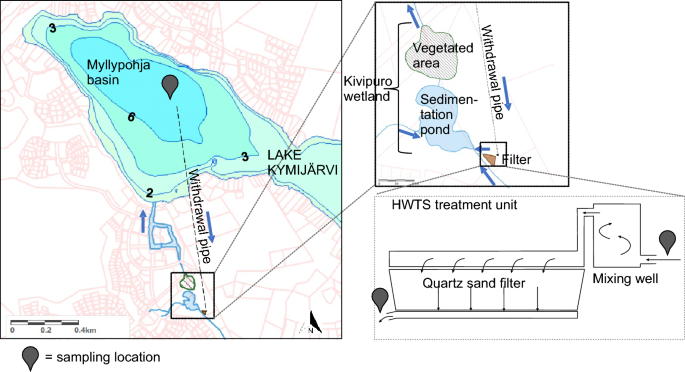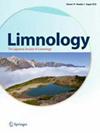Closed-circuit hypolimnetic withdrawal and treatment: impact of effluent discharge on epilimnetic P and N concentrations
IF 1.6
4区 环境科学与生态学
Q3 LIMNOLOGY
引用次数: 0
Abstract
Abstract Closed-circuit hypolimnetic withdrawal and treatment systems (HWTS) represent a novel lake restoration technique in which nutrient-rich near-bottom water is pumped through a treatment system and returned to the same lake. However, the design of such systems is not yet standardized and routing of effluent waters must be planned carefully to minimize the risk of adverse water quality impacts. Here we assessed the risk of HWTS effluent to elevate epilimnetic nutrient concentrations under a range of withdrawal and effluent discharge scenarios (4.5–45 L/s, sand filtration only and sand filtration combined with wetland) at Lake Kymijärvi, Finland. The filter of the HWTS removed most of the phosphorus (67%), but only a small fraction of nitrogen (14%). For both nutrients, filter effluent concentrations were elevated with respect to the lake epilimnion. However, the results of our calculations suggest only minor increases (0–12%) in epilimnetic phosphorus concentrations in all withdrawal and discharge scenarios. For nitrogen, somewhat higher increases (1–17%) are expected unless the filter effluent is first discharged into a wetland as part of the HWTS circuit. We conclude that the impacts of the filter effluent on the epilimnion do not mask the benefits gained in the treated lake by the closed-circuit HWTS, but use of a buffering system such as a wetland decreases the risks further.

闭路低血磷回收及处理:污水排放对血磷、氮浓度的影响
闭路低水提取和处理系统(HWTS)代表了一种新的湖泊恢复技术,该技术将富含营养的近底水通过处理系统泵送并返回同一湖泊。然而,这种系统的设计尚未标准化,必须仔细规划废水的路线,以尽量减少对水质不利影响的风险。在芬兰Kymijärvi湖,我们评估了HWTS出水在4.5-45 L/s、砂土过滤和砂土过滤与湿地相结合的一系列取水和出水排放方案下提高土壤养分浓度的风险。HWTS的过滤器去除了大部分磷(67%),但只去除了一小部分氮(14%)。对于这两种营养物,滤池流出物的浓度相对于湖水的浓度有所升高。然而,我们的计算结果表明,在所有提取和排放情景中,土壤磷浓度仅小幅增加(0-12%)。对于氮,预计会有更高的增幅(1-17%),除非过滤器出水首先作为HWTS回路的一部分排放到湿地。我们得出的结论是,过滤器流出物对废水的影响并不能掩盖闭路污水处理系统在处理湖泊中获得的好处,但使用湿地等缓冲系统可以进一步降低风险。
本文章由计算机程序翻译,如有差异,请以英文原文为准。
求助全文
约1分钟内获得全文
求助全文
来源期刊

Limnology
地学-湖沼学
CiteScore
4.30
自引率
6.20%
发文量
15
审稿时长
>12 weeks
期刊介绍:
Limnology is a scientific journal published three times a year, in January, April, and August, by Springer in association with the Japanese Society of Limnology. The editors welcome original scientific contributions on physical, chemical, biological, or related research, including environmental issues, on any aspect of basic, theoretical, or applied limnology that present significant findings for the community of scholars. The journal publishes Rapid communications, Research papers, Review articles, Asia/Oceania reports, and Comments.
The aims and scope of Limnology are to publish scientific and/or technical papers in limnological sciences, to serve as a platform for information dissemination among scientists and practitioners, to enhance international links, and to contribute to the development of limnology.
 求助内容:
求助内容: 应助结果提醒方式:
应助结果提醒方式:


